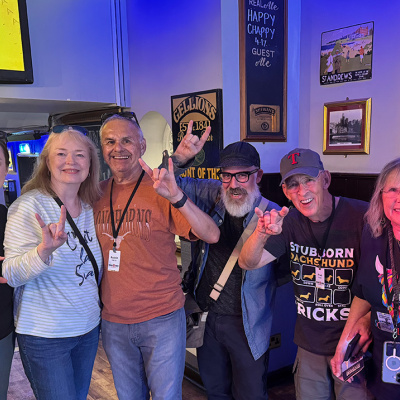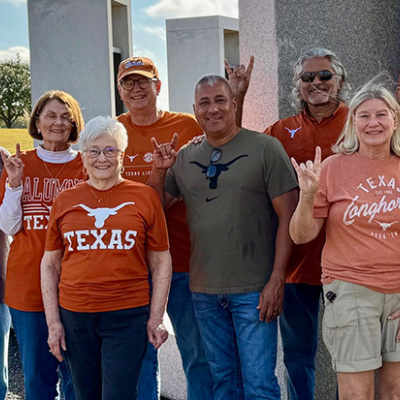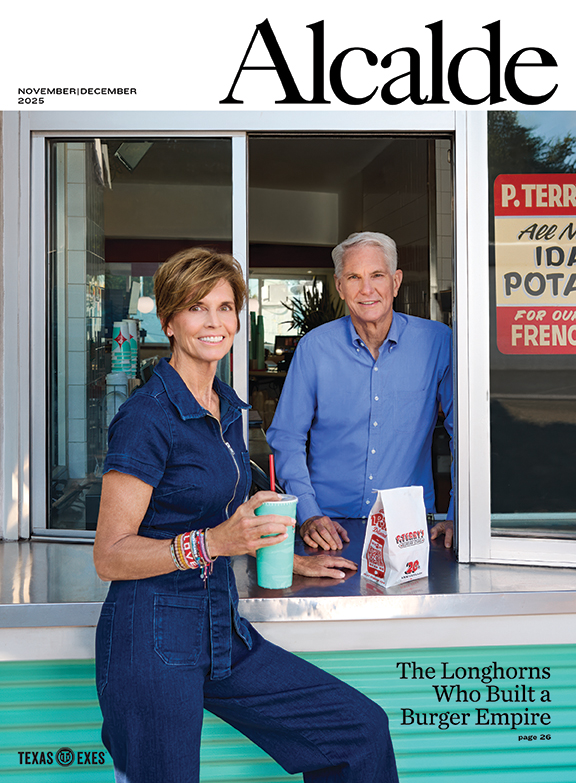Building a Better Framework
UT architectural theory guru Steve Ross is taking his big ideas out into the field—and getting students involved.

One day in 2007, Steve Ross, MS ’90, a senior lecturer in the UT School of Architecture, went to see a man about a treehouse. This wasn’t an ordinary job, but few of Ross’s projects are. The client was Richard Linklater, the Academy Award-nominated writer and director of such films as *Dazed and Confused and *School of Rock. The treehouse would be a 20-foot-tall metal structure for Linklater’s property in Bastrop. But Ross had something even bigger in mind.
Ross brought a guest with him—Jack Sanders, MAr ’05, his former graduate student. As an undergraduate at Auburn University, Sanders had participated in Auburn’s famous Rural Studio, a pioneering curriculum that brings young architecture students to Alabama’s impoverished “Black Belt” region to design and build much-needed housing and community structures. As Sanders explained the Rural Studio to Linklater and his family, the director turned to Ross.
“Rick asked me if UT’s School of Architecture ever did something like the Rural Studio,” Ross recalls. “I explained that UT did have a history of some design-build work, but not like Rural Studio. I then asked Rick if he’d like to hear my fantasy. He said yes.”
That conversation marked the first step in the formation of Design Build Alliance, a non-profit collaboration between Ross, Sanders, Linklater, former student Chris Krager, MAr ’99, and others. As Ross puts it, DBA “affords students and recent graduates the opportunity to work alongside professional collaborators in the process of developing, designing, and building affordable housing in Austin.” In concert with Ross’s service education class, Alternative Real Estate Action: Experiential Research (AREA-ER), the project is opening up new venues for young UT students hungry for real-world experience.
***
These days, Ross spends his days buzzing from campus to work sites to meetings with community representatives. It’s a far cry from the company he was keeping 25 years ago, when, as a young man, he found early success in commercial real estate investment. After years of developing and promoting strip malls, primarily in the Houston area, Ross suffered what he calls a “philosophical breakdown.”
“The motivation was to make as much money as possible as quickly as possible, with very little regard to how our actions affected the quality of life of the people and places where our projects occurred,” Ross says. “I began to feel that I may have been doing, ultimately, more harm than good. My so-called successes began to feel not so successful.”
At his wife’s suggestion, Ross quit his job and enrolled in UT’s interdisciplinary graduate master’s program in architectural theory and philosophy. There, he developed the mantra he’s repeated to generations of his own students in the School of Architecture: “Come to terms with terms on your own terms.” In other words, recognize the social, economic, and cultural framework in which you operate, and try to elevate it to the level of your best ideas and aspirations.

“I developed a strong bias that, for me, the purpose of higher education was not so much to learn to be high-quality passive order-takers to various status quos and established systems, but instead to study these established systems and to offer them better alternatives,” Ross says. He adds, “I guess, without realizing it, I was believing in what later became UT’s motto: ‘What starts here changes the world.’”
Ross developed a free-wheeling, all-inclusive classroom style that has made him a favorite of adventurous students. In over 20 years of teaching, he’s attracted a legion of acolytes, many of whom collaborate with him on projects around Austin. For instance, DBA’s first market-rate house was designed by former student Stuart Sampley, MAr ’02, and contracted by UT alums Garrett Boon, BBA ’01, Life Member, and Jake Badger, BA ’01. Linklater puts it succinctly: “Steve is kind of a pied piper of what he does.”
***
At UT, Ross’s specialty for many years has been theory. Only with his AREA-ER classes and the formation of DBA has he finally been able to bring his educational vision into the field.
“There always seems to be a great demand—more than we can accommodate—among students to get involved in actual projects,” Ross says. Each semester, AREA-ER is structured around several service opportunities in Austin. Recent classes have built and/or designed a pedestrian bridge for the women’s group Alma de Mujer, an “offshoot” performance space for theatre collective Rude Mechanicals, and a renovation of an affordable home for East Austin’s Blackland Community Development Corporation.
Many project ideas come from students. Some were volunteering with Austin-based food pantry Mobile Loaves and Fishes (MLF) when they heard about MLF director Alan Graham’s vision for a “village” of very small structures, centered on communal plumbing and cooking facilities, to house the homeless. Ross and these students met with Graham and hatched a plan.
[caption id="attachment_1654" align="alignleft" width="600" caption="Micro-house"]

[/caption]
Students competed to design a 150-square-foot “micro-house” prototype and collaborated in its construction. At the end of the semester, DBA took over the project, bringing it to completion. Since then, Ross and his collaborators have embarked on the project’s next phase, searching for 20 acres of land in Austin to buy and develop into an inclusive community for formerly homeless people.
“The micro-house was something incredibly collaborative, where design became accessible to everyone and was applied quick and dirty for a great reason,” says Corey Leamon, BFA ’11, Life Member, a former student. “I learned more about Austin’s past, present, and future in one semester than I had after three years of living here.”
For Ross, this is the culmination of a twenty-year-old dream, one that required listening to his gut instead of his wallet and setting out to find a better way of doing things. In the field, his enthusiasm rubs off on students and collaborators alike. This is never more true than when he’s talking to neighbors, learning about the people and places that his buildings will serve. “He’s almost a spiritual link to what you’re trying to build with people,” Linklater says. “I admire that. He’s trying to be congruous with everything around him, with the neighborhood, the people. He’s not some ivory tower guy. He’s getting his hands dirty.”





